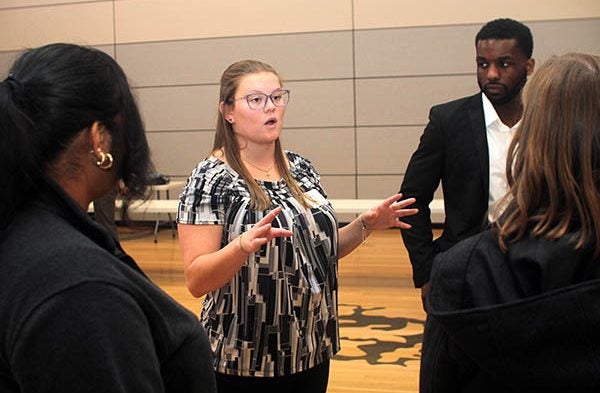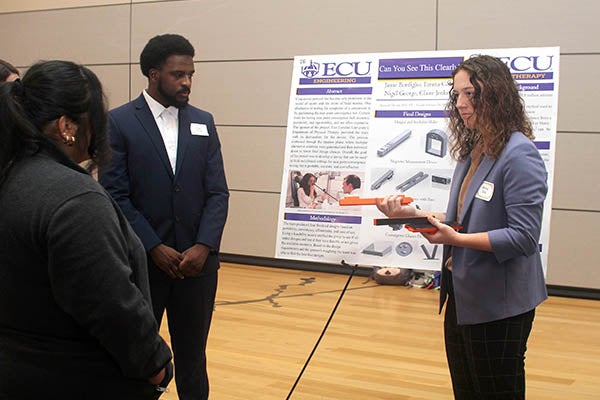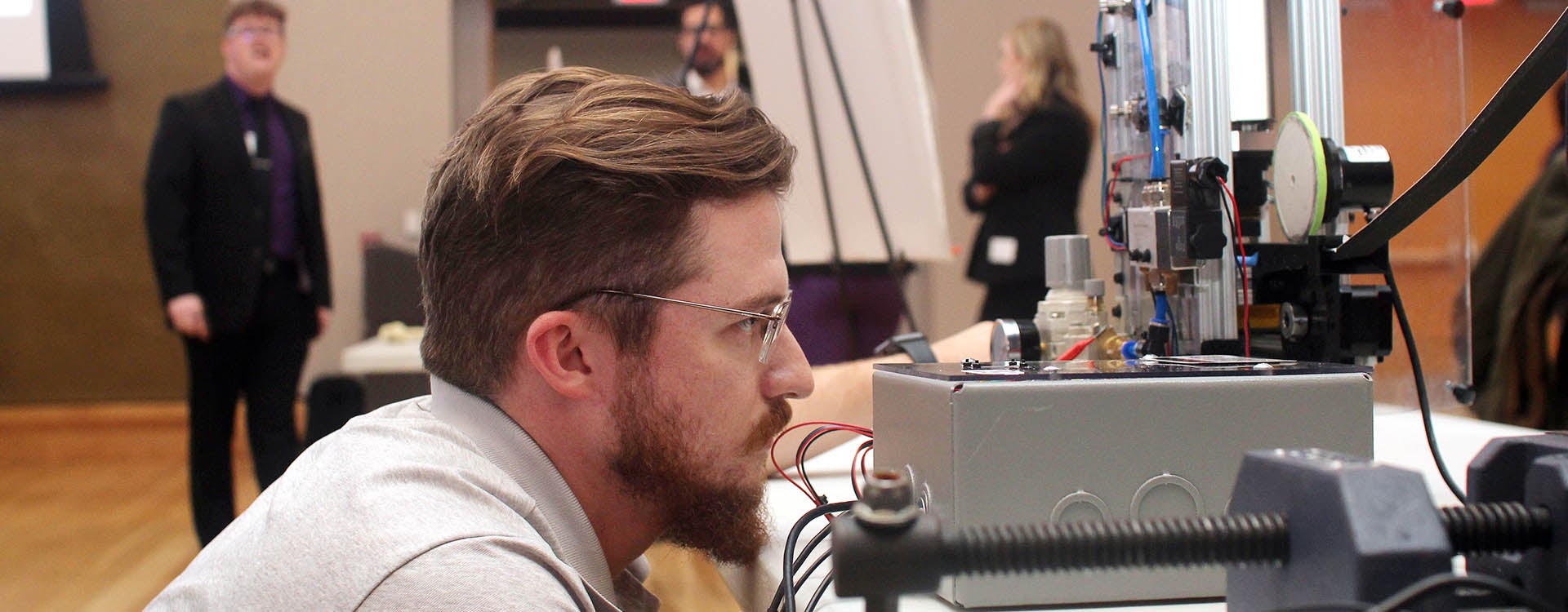PROJECTS WITH PURPOSE
ECU engineering students showcase work at capstone symposium
From health and the environment to manufacturing and defense, the East Carolina University Department of Engineering Capstone Symposium showcased student work on a variety of projects.
Engineering students must complete a senior capstone project as part of their graduation requirements, but when analyzing their work during the symposium, many noted the importance and impact the projects may have on the region and nation, making their work much more meaningful.
Gavin Adams, Brandon Burris, Emily Fenton and Cassidy Green worked on a project that could help the roughly 185,000 people who will undergo a major limb amputation in a year. The application of a compression sleeve, or shrinker, is needed to help patients after amputation, but the method in which that shrinker is applied could impact patient recovery and comfort. The students determined that using a donning plastic tube to apply the shrinker proved better and provided more consistent pressure to the wound area than a manual hand application.
“You can imagine how sore and tender that area must be,” Adams said. “It should be about .3 to .4 pounds of pressure per square inch. If it goes any less, you’ll have swelling, and all that swelling would go to one spot and be very problematic for the patient. The idea is just to make sure it can heal in the shape a prosthetic can fit to after surgery.”

Students Sarah Hicks and Crawford Chandler talk about their senior capstone project called Pee Dee’s Sensory Trailer.
Josh Ali-Martinez, Meredith Bullard, Crawford Chandler, Sarah Hicks and Austin McAllister are working on what they call Pee Dee’s Sensory Trailer. Designed to be mobile, the trailer will house calming sensory intervention devices that will allow those with neurodivergent issues a place to ground themselves and regain control of their emotions at ECU football or baseball games, or at community events.
“I’m personally very excited about this project,” Hicks said. “I think it’s very special to be able to include everyone in different environments and places in the community. I struggle with anxiety, so this would be something I could utilize if I was overstimulated from any type of environment. It’s definitely something I think will be very important and useful in the future.”
Work on the project will continue in the spring. Students hope to get the trailer next month, and will begin work on the electric panels and start to purchase sensory materials. They’re looking to test the trailer some baseball games this year, with a rollout in time for the fall 2023 ECU football season.
“Everything is important — the light color, the carpet color, the materials that we put in it,” Hicks said. “We need to be able to appease so many people’s senses and make sure they can deal with their SIMs (sensory integration methods) the way that they need to.”
With concussion diagnosis and protocol almost a daily conversation for athletic teams, students Jamie Bonfiglio, Emma Cole, Nigel George and Claire Jenkins are working with ECU’s Department of Physical Therapy on a portable and more reliable near point convergence testing device.
“I worried in the summer about getting a project that I was going to really care about, but this one is something I definitely care about,” Cole said. “I play a lot of sports, and I know my team members have played sports in the past, so just knowing that we can relate to this project is nice and really helped us be more involved in the process of making this device.”

Students Emma Cole and Nigel George talk about talk about their project designed to help with concussion protocol.
The students developed four prototypes and will test the devices this spring, select a final design based on those tests and build it, with an eye toward the long-term manufacturing process.
“The group in general, we’ve been working together since freshmen year,” Cole said. “We were surprised we got picked to be together on this project, so it was really nice having a group of friends to get together and work on a project that we all actually really enjoy.”
The students working on the various projects learned that not all things go as planned. Holden Duckworth, Joseph Ha, Joshua Cherry and Mason Caroon worked on an automated gasket cutting device for Pamlico Air. The team had to design a device that could cut neoprene gaskets from 10 to 32 inches in length in about 10 seconds, while making the device safe and easy to operate.
“We realized we had to buy a bigger press because the old press was 100 pounds and the new one needed to be 300,” Caroon said. “We had to scramble to implement the new one into an already existing design. The feeding mechanism gave us a little trouble, but it was nothing we haven’t been able to overcome so far.”
The project tested the students’ skills in a variety of subjects such as coding, electric circuits, design, 3D printing and manufacturing.
“We were very lucky to get this project,” Caroon said. “It was a really good capstone project.”
Students Dean Feinstein, Michael Rodriguez, Sophad Long and Alex Roach were tasked with creating a centrifugal pump testing stand for Carver Machine Works. The stand is designed to detect leaks or other problems in pumps that have been refurbished, but the team had to redesign the piping system on its first design.
“The total length of the piping loop system was around 23 feet, but our space constraint was 12-by-12,” Rodriguez said. “Halfway through the semester, we had to redesign our system and condense it. Luckily, it wasn’t a huge difference. We just shrunk it down and changed the design of the water tank because it’s easier to manufacture if it’s a cylinder as opposed to a rectangle.”
Despite that challenge, the team embraced the work.
“It was fun to make,” Rodriguez said. “This is one of the most complicated things we’ve had to design in school, and I think it showed our talents and what we learned at ECU.”
Nineteen teams displayed projects during the symposium, and 22 engineering students who will be part of the fall 2022 graduating class on Dec. 16 were recognized at the conclusion of the event.

Student Holden Duckworth examines his senior capstone team’s automated gasket cutting device.
